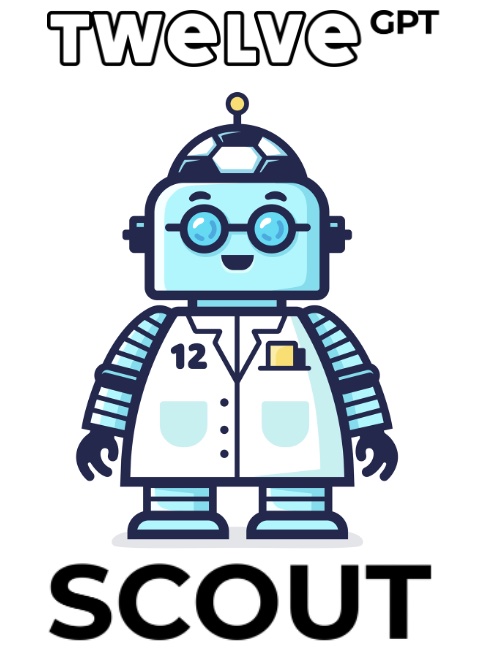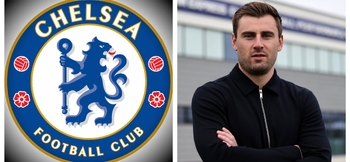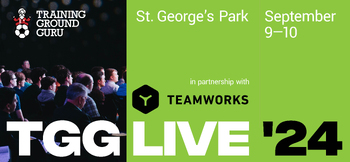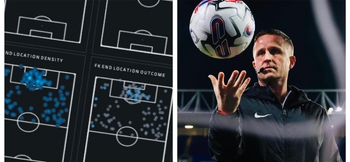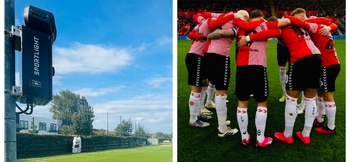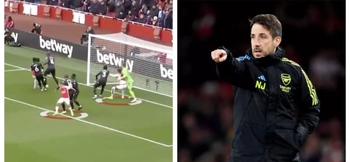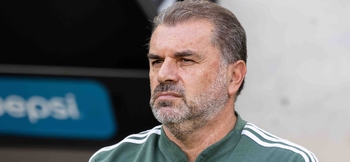TGG Podcast #51: Conor Nestor - Using analysis to get ahead in Asia
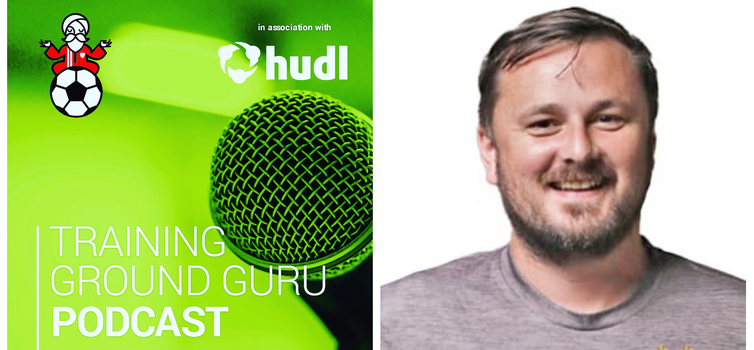
Conor Nestor was a Development Officer with the Football Association of Ireland for eight years before moving abroad
Written by Training Ground Guru — July 14, 2023
WHEN Irishman Conor Nestor got an unexpected opportunity to manage Svay Rieng in Cambodia, he grabbed it with both hands.
He transformed the way they operated behind the scenes, including a complete revamp of their analysis and recruitment operation. Previously this has been agent and trial-based, before Nestor brought in bespoke dashboards and player profiling with the help of Hudl and Wyscout.
In Episode #51 of the Training Ground Guru Podcast, Nestor explained how analysis helped him to land the league title in Cambodia - and about his plans at new club Hyderabad FC in the India Super League.
You can listen via the Player below and read an edited transcript of the interview after that.
UNEXPECTED JOB IN CAMBODIA
Conor Nestor: The football industry in Ireland was quite small and closed off. I felt that if I was going to develop as a coach then I was probably going to have to leave.
My travels after the FAI took me to America and Melbourne. A good friend offered me a job to stay in Australia for two years and I had to go on a sponsorship visa. He advised me to go to Phnom Penh for six months while the process was taking place.
I flew to Cambodia and did some work in international schools and coached a semi-pro team in the evenings. They got a result or two that they shouldn’t have and then Svay Rieng knocked on the door and said, ‘Would you like to be our Head Coach?’ It took me about six seconds to decide.
They were a good team with good players. In terms of a football club there wasn’t a structure there or clearly defined departments though. It was basically, ‘We put on training sessions and play games.’ They were very successful in cup competitions with that attitude.
I pitched something very different to the CEO - ’Let’s build a football club with different departments, like sport science, analysis, scouting, recruitment; let's build a community section; let’s think about a new training ground and pathways from the Academy.’
Fortunately the CEO, an Australian, went for the big vision. I was so lucky to go into a club that gave me a blank canvas and I was probably the lead person from a football perspective. I had a General Manager from Edinburgh called Christopher Grant, who was a great support to me.
But I was very aware I had to have a proof of concept with the CEO and the owners.
'SCOUTING AND RECRUITMENT DIDN’T HAPPEN’
The season before I arrived, all five players the club signed were in Cambodia already. In some cases an agent would have flown them in on trial with a load of different teams, or else they were in the league already.
When I went to games, I wasn’t bumping into peers.
GETTING HUDL AND WYSCOUT ON BOARD
When I went to Cambodia, it was always my desire to get Wyscout involved. When I'd left the FAI in 2016, I sold my house and signed up to Wyscout as an individual user. I paid a monthly subscription and had access to five leagues, because I wanted to be able to study different coaches and leagues.
So when we got that proof of concept from the owners, I reached out to Wyscout and said, ‘We’d like to step up what we’re doing on analysis and recruitment. How does that look and how much does it cost?’
With Wyscout you can do data searches for players in a very quick and easy way, set up player lists, compare players. Those tools for us were a dream, when what we had stepped into was a very agent-based, trial-based recruitment system.
It’s quite time-consuming to do due diligence on a player. It’s not just ‘the data looks good,’ it’s a lot of video. This is where Wyscout really helps. You can go into specific areas and it allows you to learn more about a player in a fast way.
What Hudl did in the end was design a specific dashboard for us for how we play and position-specific metrics. They had a Tableau-based dashboard for us, with a scattergraph for different positions.

This scatter plot used specific metrics Nestor wanted. The indexes are linked to the way a team want to play and combine different data KPIs into a single index score for defence and attack. When you clicked on a player (one of the dots) you were taken straight to their Wyscout platform page, with videos of the player.
Then they built a system where we could track leagues that were important for us and it became a very good visualisation tool. When you talk about recruitment, you want to be able to visualise the end outputs.
If you’re changing four players, you have your underlying metrics from last season and know where it went wrong and where you want to get wins. You know with the data what you’re losing and you want the visualisation of what will happen if you bring in these guys.
We don’t have the resources to look at 100 players, so how do we minimise it to a number we can do due diligence on?
QUANTIFYING OUR GAME MODEL
We wanted to be high-possession, high press. If you look at 100 leagues in world football, 90 of them are won by the most dominant team in terms of owning the ball and winning it back quickly.
We wanted to get more than 60% possession, because then we should be able to be in the opposition half more often and be able to regain the ball in the opposition half.
It happens I like to play football that way too, but it wasn’t a stylistic thing, we wanted to win and it was what winning teams look like. That grew over time and it really kicked into gear when we got Wyscout and Hudl involved.
If we played a six o’clock fixture, we tried to get 20 ball recoveries in the attacking third. If we had a 3.30pm fixture, which was red hot, we would adjust and go for 15. In those games we tended to drop the block a bit deeper and press off triggers a bit more.
PPDA - passes per defensive action - we tried to be nine or less. So that’s allowing nine passes before there’s a defensive action. That sounds like a lot but if you looked at Man City last season, off the top of my head they would be 6.8 or something along those lines.
Why is it less? You have to work with the players you have, in the league you’re in in the climate you’re in. These targets have to be attainable, otherwise people get demotivated very quickly.
Most seasons on the PPDA we were top of the league or second. The possession varied, depending on the recruitment process and also covid and lockdown, when you were training in small numbers or not even training. Also, playing this style, playing multiple games in pre-season is so important, because of fitness and also being refined in your touches.
Deep completions was another metric that was really important to us, so receiving the ball 20 metres from the end line and we were trying to do that more than 10 times a game. Box touches we were trying to get 20 a game. Isolated, these metrics don’t mean anything, but when you add them together it probably means you did dominate the game.
xG evolved over time. To begin with I wanted to win the xG battle by 1.0 or more, but then I realised that’s creating three good chances more than your opponent, which is difficult, so we adapted it to 0.35.
SIGNING PLAYERS TO FIT THE GAME MODEL
With the dashboard with Wyscout, we were able to profile our different positions. There were different metrics for each. Say with the deep lying playmaker, it was interceptions and progressive passes we would focus on.
With a centre-back, for example, through Wyscout you can look at his one-on-one defending and whether he makes good decisions; you can click on covering depths and see if he will be in the right positions defensively.

Scattergraph of strikers. Indexes are xG per 90 and touches in the box per 90. Again, each dot corresponds to a player and can take the user to the player's Wyscout page.
Every player we signed, no scout had watched them live. It was a big stretch for me to even get Wyscout deals over the line. There are so many unknowns in recruitment. When you only get five foreign signings and four on the field, you can’t afford a 50% success rate. Using the Hudl and Wyscout platforms helped me to minimise searches, which helped me on time management.
That’s crucial when you don’t have a huge body of staff. We were the most consistent team over five periods because of our players and had a much better than 50% strike rate.
Right from the start, the Hudl customer service was top level. I was probably asking questions that weren’t getting asked and it was never a no, it was always a ‘we’ll get back to you’ or ‘let’s work on solutions.’ That’s how our relationship over time evolved, to them designing a bespoke dashboard for us.
With their products and customer care we were able to build what we wanted for our budget and recruit the best possible players and then try to improve them when we got them through consistent analysis and interventions with the team and individuals.
TWO WINS, TWO DRAWS, TWO LOSSES…. AND A RIOT
Year one did not go to plan at all. We had a riot in my seventh game. Two wins, two draws, two losses and game seven a riot! Not exactly the thing dreams are made of.
There was some handbags and our kit man made his way onto the field. A Japanese player on the opposite side punched him and in Asian culture you really respect your elders. It was a red rag to a bull. The stand emptied - fans, staff - and it was chaos for 10 minutes maybe. I was actually stood in my technical area, I was waiting for a Jeremy Beadle to peel out of the crowd and say, 'We’re having you on,' but it was real.
I was a bit annoyed, because I did so much due diligence in taking the role and didn’t see any red flags in terms of discipline. They didn’t actually have the confidence straight away for how I wanted them to play, but they were good professionals, so it really shocked me.
The game re-started, although the referee might have blown it up a bit early! We had seven players banned for 11 games with 14 games left. Four were internationals and two were goalkeepers. You can only put four foreigners on the field so typically you don’t field foreign goalkeepers.
At the time it was hell but it ended up being a real blessing in disguise, because young players got opportunities, the fear factor of playing how I wanted them to had gone and we won the last three games of the season.
TURNING POINT AND WINNING THE LEAGUE
That ended up being part of a 33-game unbeaten run when we won the league the next season as well and were one game away from being invincible. I think we set a new standard in the league and the changes at a club level started to be norms in Cambodia.
We were quite proactive in recruitment and got players in early. Most clubs now do that and are also using some analysis and GPS and so on.
It was a great time in Cambodia, we were the most consistent team in the country for five, six years. We went to the last day of the season in 2020 and lost on head to head, even though we had a superior goal difference, because of Covid.
Then 2021, last day of the season as well, penalties in a cup final again. We were the first team in Cambodia to beat the Indonesian champions in the equivalent of the Europa League. We played 12 different international games and won 10 of them. So we managed to do some things that hadn’t been done before.
We have a new training ground, a new stadium, they moved the Academy to start with younger players. I would have liked to have won more trophies, but in terms of going into a club and having them back how you things should be done it was a great first place for me.
JOINING HYDERABAD FC
Hyderabad is a very interesting project. It is a club that gives young players and a chance and the market dictates that some of the really big budget teams come and buy your best talent. I have come in during of period when there have been a lot of changes, with outgoing players and a new cycle is starting. My appointment is part of that.
One of the main reasons I jumped on a plane and came here was they had more of a support system around a Head Coach and I felt after five seasons in Cambodia that I wanted to come into an environment with a Sporting Director and team of analysts. Then you learn how to manage those relationships and work within those networks.

The Indian Super League (ISL) has moved like the MLS. At the beginning they had the older players and bigger names but now it’s moved to developing younger players and shopping in leagues with a re-sale value.
In the past cricket was in one part of the year and football in another but now it’s more of a football calendar. A lot of that was dictated by the Asian Football Confederation.
This is the 10th year of the ISL and it has developed a lot in a short time. In a country where cricket is a religion it’s a difficult transition from the big names who bring a lot of attention to now. Yet I feel the end product is a lot better.
Here is Hyderabad we are going into our fifth season and football is probably the number two sport. It’s can you grow it to number one and win the hearts and minds of the local community and make it sustainable.
EVOLVING OUR SCOUTING AND RECRUITMENT EVEN FURTHER
The off-season recruitment has been massive. It's been me and the Sporting Director and the three analysts spending way too much time together in trying to get the best players in.
If you want to be a good coach you get good players. If you want to be a great coach you get great players. As much as we back ourselves as coaches, at the end of the day if you get your recruitment right you’re onto a winner.
That is probably how we are going to grow here and I hope we can develop a similar relationship here with Hudl and Wyscout where we can make it bespoke for Hyderabad.
We are trying to get though this first window. It’s difficult, because it’s a transition period, but I have plans for five leagues really that we are going to target really and having a video scout who can also get to games.
We recently found two players we loved in Argentina but unfortunately we don’t have the strength on the ground there to get the references to back up whether they are the people we want. Most of the time when a signing didn’t work at Svay Rieng it was more on the personal side, because they failed to adapt to the culture or dressing room or to me.
When you are watching full games you are looking for body language, reactions with team-mates, how they react to being substituted and even how many team mates celebrate with them when they score. There are things if you watch live you can pick up on that you can’t on video.
At the end of this season if everybody can see what we are trying to do and we get closer to that year on year, then trophies will come.






